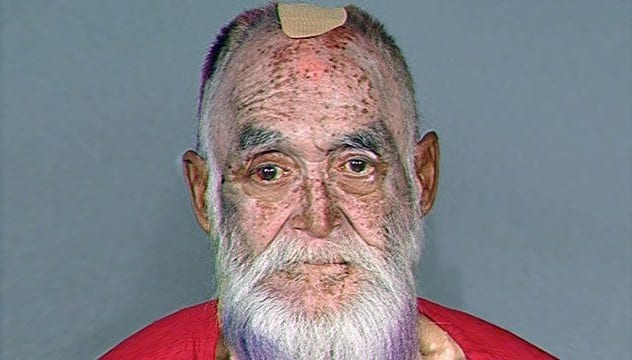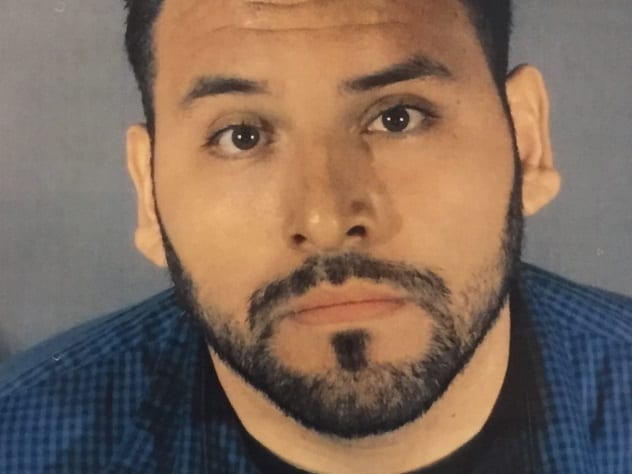 Mysteries
Mysteries  Mysteries
Mysteries  History
History 10 Surprising Stories About the Texas Rangers
 Humans
Humans 10 Philosophers Who Were Driven Mad by Their Own Theories
 Miscellaneous
Miscellaneous 10 Video-Game-Worthy Weapons and Armors from History
 Weird Stuff
Weird Stuff 10 Psychics Who Accurately Predicted Wartime Events
 The Arts
The Arts 10 Pieces of Art Inspired by a Broken Heart
 Health
Health 10 Science Fiction-Sounding New Medical Treatments
 History
History 10 Surprising Facts About the Father of Submarine Warfare
 Space
Space Ten Astonishing New Insights into Alien Worlds
 Weird Stuff
Weird Stuff 10 Bizarre Summer Solstice Rituals Still Practiced Today
 Mysteries
Mysteries Top 10 Haunting Facts About the Ghost Ship MV Alta
 History
History 10 Surprising Stories About the Texas Rangers
 Humans
Humans 10 Philosophers Who Were Driven Mad by Their Own Theories
Who's Behind Listverse?

Jamie Frater
Head Editor
Jamie founded Listverse due to an insatiable desire to share fascinating, obscure, and bizarre facts. He has been a guest speaker on numerous national radio and television stations and is a five time published author.
More About Us Miscellaneous
Miscellaneous 10 Video-Game-Worthy Weapons and Armors from History
 Weird Stuff
Weird Stuff 10 Psychics Who Accurately Predicted Wartime Events
 The Arts
The Arts 10 Pieces of Art Inspired by a Broken Heart
 Health
Health 10 Science Fiction-Sounding New Medical Treatments
 History
History 10 Surprising Facts About the Father of Submarine Warfare
 Space
Space Ten Astonishing New Insights into Alien Worlds
 Weird Stuff
Weird Stuff 10 Bizarre Summer Solstice Rituals Still Practiced Today
10 Absolutely Strange Ways Brutal Murderers Got Caught
From fingerprints to forensic science to good old-fashioned intuition, there have been many ways to catch murderers. Archaeological sites show that murder has been with us since the very beginning of human history. Some murders have taken decades to solve, but thanks to modern technologies like DNA testing and the genius of sometimes creative detectives, murderers are becoming increasingly easy to catch, try, and bring to justice.
Contrary to popular belief, there is no real archetype for even a serial murderer, no generic composition of traits we can safely assume cause or correlate with serial murder, let alone singular murder,[1] which is strikingly terrifying when we stop and think about the possibility that the tendency to murder lies within us all. Am I capable of murder? Are you? This means investigators have to work extra hard, sometimes coming up with strange and unusual methods and tools to aid in their process of catching killers. Here are ten murderers who were caught using some unusual methods.
10 Blood Bank

Joseph Paul Franklin was an American serial killer who committed his first murder in 1977, the alleged Golden Age of Serial Killers. He was a rabid white supremacist and neo-Nazi who looked up to Joseph Goebbels, the nefarious Nazi who killed his own children with suicide capsules. He started off with minor assaults, using pepper spray on people of color, and then graduated to robbery and eventually murder, using a hunting rifle as his tool of the trade to claim the lives of over 20 people and injure more. He considered his murders a “mission” whereby he would fight against people who were not of the white race. On October 8, 1977, Franklin would commit the crime that he would later be sentenced to die for, when he climbed a telephone pole by hammering 25-centimeter (10 in) nails into the pole, setting up a makeshift gun rest, and firing, killing a man who was leaving a synagogue. But Franklin would mark a major change in the way criminals were captured by being one of the first notable serial killers to be caught by using criminal profiling
Franklin was able to evade detection for a few years, until a police officer noticed his gun in his car and pulled him over, ultimately arresting him. He was brought in for questioning on warrants but escaped police custody. However, the FBI had their man, or so they were pretty certain from the profile at the time. They noted two details which helped them pin Franklin to the murders: his tattoos, which were provocative and racist in nature, and his drifter lifestyle, which helped him evade capture but also forced him to rely on payments from blood banks to survive. After he escaped to Florida, Franklin was recognized by someone who operated a blood bank and was turned in to the FBI from there.[2] His reliance on blood donations ended up being his downfall, in combination with the criminal profile the FBI was able to put together.
9 High School

Richard Trenton Chase, otherwise known as the Vampire of Sacramento, was a serial killer from Northern California, and he was quite the literal vampire. Chase was a complete oddity of a human being, even as far as serial murderers go, in that he not only believed that he needed to drink blood to be happy, but he delusionally believed that it was the only thing that would make and keep him well. Suffering from bouts of hypochondria, Chase thought that the only thing that would cure him of the various sicknesses that his sick mind would dream up was the consumption—or even injection—of animal or human blood.
Chase would ultimately kill six people. He would test front doors at random, and if he found one unlocked, he would go inside and murder whoever lived there to consume their blood. The guy was obsessed with blood, to the point of being hospitalized for injecting animal blood into his veins.[3]
In the end, Chase was caught by a quite unusual turn of events, when a young woman he had gone to high school with recognized him when he approached her car. Richard had bloodstains on his shirt. She notified the police of her suspicion that Richard Chase was indeed the vampire who’d been murdering people, and the police were able to track him down in his apartment, where they found his blood-soaked sweatshirt. He was brought to trial, surprisingly found competent, and sentenced to die. Richard Trenton Chase killed himself in prison via a drug overdose in 1980.
8 Footprints

Gordon Veitch, unlike the other people on much of this list, wasn’t a serial killer but a murderer who killed one person in Scotland. On March 15, 2013, he killed Brian Bathgate with a knife.[4] After Veitch stabbed Bathgate in the neck and fled the scene, an 18-month-long investigation ensued, in which detectives tried to piece together what happened on that fateful night in 2013.
Left behind, unbeknownst to Veitch, was the one thing that would get him caught through new investigative analyses: footprints. Gordon Veitch left bloody footprints at the scene, and forensics were able to determine his specific walk, with his right foot pointed outward, and match the footprints to the crime scene, gaining them a conviction. Under Scottish law, Veitch was sentenced to a minimum of 16 years in prison for the murder of Brian Bathgate.
7 Chewing Gum

Gary Raub was a murderer who killed a 70-year-old woman from Augusta, Maine, named Blanche Kimbal after entering her home way back in 1976. Blanche Kimbal fought her attacker, but it was a losing battle, and she was stabbed over a dozen times in her head and chest. It took decades to solve the case, but Raub was finally arrested for his crime in October 2012, when the police department in Augusta conducted a review and some lab tests which singled Raub out as a possible match for DNA, making him a suspect.[5]
Raub had been held and questioned back in 1976, but it wasn’t until DNA testing on blood found at the Kimbal crime scene proved to be from a man that the focus really narrowed on Raub, who was living in Seattle. Then, the police devised a genius ruse, a plan to trick this killer into submission: They held a fake experiment that involved chewing gum, and an undercover officer got the now-63-year-old Raub to participate. They were able to extract DNA from the gum and match it to the blood found at the crime scene all the way back from 1976. Gary Raub would be brought up on murder charges for the slaying of Blanche Kimbal.
6 Exhumation

This was an unusually cold case, and an unusual, long path was necessary to catch a murderer. Way back in 1957, Maria Ridulph (left above) was murdered in the middle of town. A man walked up to her and her friend, gave her a piggyback ride, and then left. Maria would then go home to get some toys and was never seen alive again. Jack McCollough (aka John Tessier) was the man, and he was questioned but never charged with anything for lack of evidence.[6] In 1994, Jack McCollough’s mother confessed on her deathbed that she had made a false alibi for Jack back in 1957. His mother even implicated him in the crime, claiming that he did it.
But the case wouldn’t be reopened until 2008. As detectives pieced the puzzle together, they were forced to exhume the body of Maria Ridulph in 2011, in hopes of gathering evidence against McCollough. Their efforts paid off. Jack McCollough was brought to trial for the 1957 murder of Maria Ridulph in 2012 and convicted. However, a judge dismissed his conviction in 2017.
5 Floppy Disk

The BTK (Bind, Torture, Kill) Strangler, aka the BTK Killer, Dennis Rader was a serial killer from Wichita, Kansas, who would end up taking the lives of ten people, including the Otero family in 1974, which was the beginning of his murderous rampage.[7] BTK started off by killing a family of four, a mother, father, and their two children, through the method he would become infamous for—binding his victims with rope, wire, or clothing, strangling them almost to the brink of death, and then allowing them to regain consciousness, only to repeat the process of torturing them all over again.
Rader would evade police detection and capture for approximately 30 years, all while maintaining the facade of a perfectly happy, normal life, complete with marriage and church service. In October 1974, after his first few killings had taken place, Rader began to pen the authorities, the local newspapers, and the police, and taunt them, referring to himself as “BTK,” which caused a media sensation and gained the serial killer the notoriety he so badly desired. In this exchange, Rader would send the IDs of his victims, articles of their clothing, drawings, letters, poems, and other disturbing items to show off that he was, in fact, the killer. This would spark off a long, 30-year game of cat and mouse between Rader and the police. His tenth and final murder would take place in 1991. After almost 20 years of killing intermittently, Rader was still a free man, roaming around uncaptured by authorities.
And he fell largely silent until one fateful day in 2005, when BTK decided to spontaneously send another letter to the police—only this time, the killer went digital. Having been a notable member of his local church and president of the congregation council, Rader decided to use a floppy disk on the church’s computer to write his soon-to-be captors. In 2004, a 1.44-megabyte floppy disk arrived in a padded envelope at the Fox station KSAS-TV. Unbeknownst to Rader, the police were able to extract the metadata off the disk and determine where it was from. They were able to discover that it was last edited at Christ Lutheran Church, and the metadata even showed that the document contained on the disk was last edited by someone named Dennis.
Rader was arrested on February 25, 2005. Police had also taken DNA samples from his daughter to match to the crime scenes, a technology which wasn’t available or very advanced through almost the entirety of BTK’s killing career. Dennis Rader would be tried, confess, and would end up in prison for his crimes, where he will spend the rest of his life. Kansas did not reinstate the death penalty until after Rader had committed his last murder in 1991, and thus, even though Kansas had the death penalty at the time of his capture and trial, the state handed him ten life sentences.
4 A Letter

Peter Kurten was another brutal serial killer who was caught by complete freak accident. Kurten committed his first murder at only nine years old, a double homicide by drowning two other boys on a rafting trip. Between 1913 and 1929, Kurten murdered at least nine people and tried to kill at least 31 others. He would eventually receive the death penalty for his crimes and was executed by the guillotine.[8] After a long killing spree, this psychopathic murderer would end up entangled in a story-like twist of fate that seems straight out of fiction.
In 1930, after Kurten had terrorized Germany, causing hysteria and panic throughout the country, a young woman named Maria Budlick moved to Kurten’s hometown of Dusseldorf and would respond to an advertisement for a place to stay. Knowing that the monster was out there, she kept a watchful eye but met the man who was supposed to provide her with a new place to live. But when the man asked her to cut through an alley with him, she became startled and refused, thinking she was face-to-face with a serial murderer. The man was highly offended, and a dispute broke out. Then another man, Peter Kurten, the actual killer himself, stepped in and escorted the woman away from her fight. She was walking right into the arms of a murderer. He took her to his home, where he would attempt to have sex with her, but when she refused, he took her back to the train station and raped her in the nearby woods. He later said that he did not kill her because she did not resist the rape.
Maria Budlick, after being raped, decided not to go to the authorities but rather penned a letter detailing what had happened to a friend of hers and sent it through the mail. In a total freak accident, the letter was delivered to the wrong address, and the person who received the letter turned it in to the authorities, who promptly contacted Budlick. She then gave police the full story, and they came to Peter Kurten’s door looking for answers. He and his wife sneaked out of his home and got away. However, as the Great Depression was just beginning to set in and take hold, they came to the realization that his wife would never survive supposing something happened to him. In a bizarre twist, this horrible serial killer and rapist decided to do one selfless thing in his entire life: He confessed his crimes to his wife and asked that she turn him in for the handsome bounty on his head. She obliged.
3 Genealogy Website

Like Dennis Rader, Joseph DeAngelo would get away with murder for a long time—a very long time. Throughout the 1970s and 1980s in California, the man, then only known as the Golden State Killer, committed at least 12 murders and at least 50 rapes. This monster would evade capture for decades until early 2018, when authorities would finally be able to link him to his crimes using the latest in DNA technologies with one other aid: a genealogy website.[9] People who submit their DNA for testing by genealogy websites online have much less freedom and security with their DNA, or even their family’s DNA, as opposed to other DNA databases.
Police were able to track him through an ancestry website and were able to find him at his home and obtain a DNA sample, which they then linked to the crime scenes he’d left behind. This ended a 40-year chase. The real kicker? Joseph James DeAngelo, it turns out, was a police officer at the time of his rapes and murders.
2 Condoms

John Miller was a killer responsible for the rape and murder of a young girl named April Tinsley, who was only eight years old. The deplorable crime took place in Indiana in 1988, though Miller wouldn’t face justice until July 2018, 30 years later.[10] At the original crime scene, police collected DNA, the analysis of which wasn’t the most exact science at the time. But it would be through a bizarre turn of events in 2004 that a trio of unusual objects would end up being the missing link that brought John Miller to justice: three condoms.
Miller attached letters confessing to the crime, each of them containing a used condom, to the bicycles of three girls. It was those condoms, along with digging through Miller’s trash at his home in 2018, from which police were able to extract DNA evidence to use against him. The DNA from the original crime scene, from the condoms left in 2004, and from the condoms discovered at Miller’s home in 2018 all matched, and he was brought up on charges of rape and murder.
1 Saliva

Geovanni Borjas has to have had the ultimate twist of fate. In 2011, 22-year-old Bree’Anza Guzman and 17-year-old Michelle Lozano were murdered after being raped. The two murders took place in Los Angeles, and their bodies were dumped alongside freeways, eerily similar to how the Hillside Stranglers disposed of their victims. DNA taken from the crime scenes was ran through police databases, and it turned out that Borjas’s father had been arrested on a domestic violence charge and came up as a close relative of the actual killer responsible for dumping the two women.
But police needed an exact match. So, they tailed Geovanni, following him until they saw their moment when he spit on the ground. The police then gathered his saliva and found a DNA match between it and that found at the two crime scenes, which was enough evidence for them to make the arrest.[11]
+ Dating Apps

Danueal Drayton was a man who would be brought up on charges when police uncovered his modus operandi of rape and murder: In July 2017, he was accused of murdering a Queens woman named Samantha Stuart and raping and attempting to murder another woman in California, using nothing other than dating apps to find his victims. In this day and age, dating apps can be fun for people looking to socialize with the ease of digital technology, but it can also be a fertile breeding ground for rape and murder.
Drayton is also alleged to have held a woman hostage in North Hollywood after taking her out on a date after he’d met her through an app—and his app history was there for all to see and to provide the police with evidence against Drayton in court. Drayton was found competent to stand trial in 2018.[12]
I like to write about dark stuff, horror, history, and philosophy.
Read about more unique ways criminals have been brought to justice on 10 Criminals Caught Thanks To Their Own Stupidity and 10 Grisly Historical Murderers Caught Thanks To Forensics.








